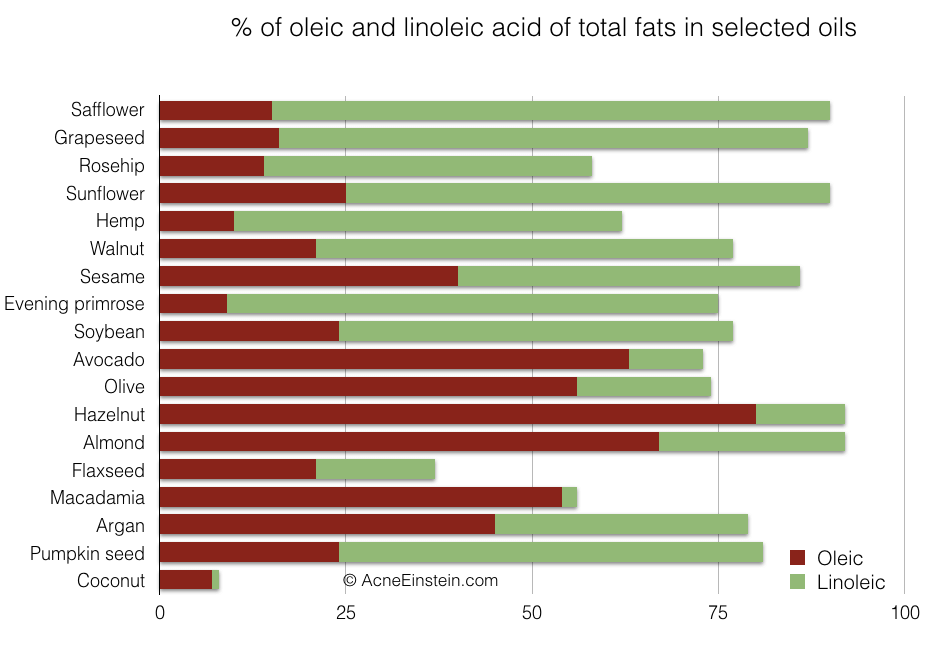For many people with acne or oily skin, putting oil on the face seems like the last thing to do. However, there are some cases where using oils topically can help.
Benefits of using oils topically include:
- They can work as non-irritating cleansers. Many people with irritant-type acne have so sensitive skin that they can’t use regular cleansers. Applying some oil on the face and wiping it off with a wet cloth can cleanse the skin without irritating it.
- They work as effective, natural moisturizers. Oils don’t add any moisture to the skin, but they form a waterproof barrier on top of the skin that prevents moisture from escaping the skin.
- They can provide linoleic acid (LA) to the skin. In the what causes acne page, I talked about the role linoleic acid plays in acne. A few of studies have shown that using skincare products with LA can reduce acne.
Be wary of “beauty blog” advice about skin care oils
If you do a Google search for skincare oils, you’ll find all sorts of “advice” on the types of oils suitable for different skin types and skin conditions. None of that advice is based on science or evidence.
I have a good reason to be skeptical of what’s touted on various natural health and beauty blogs. The main reason being is that oils don’t penetrate the skin. You’ve probably read things such as ‘like dissolves like’ to justify the use of oils. But here’s where your common sense once again betrays you.
Fatty acids in oils are bound together into triglycerides, and triglycerides don’t penetrate the skin in any meaningful way. Even your intestines can’t absorb them until the fat-digesting enzymes have broken them down into individual fatty acids.
In 2012 German researchers used a laser scanning microscope to investigate the skin penetration of paraffin oil, Vaseline, jojoba, soybean, avocado, and almond oils. The researchers concluded:
Paraffin oil, as well as the vegetable oils, penetrated only into the first upper layers of the stratum corneum. Thus, a deeper penetration can be excluded.
Patzelt et al. In vivo investigations on the penetration of various oils and their influence on the skin barrier. Skin Res Technol 18, 364–369 (2012). https://www.ncbi.nlm.nih.gov/pubmed/22092829
Stratum corneum refers to the topmost layer of the skin that’s composed of tightly packed dead skin cells. Together with sebum, this layer forms a physical barrier to protect the layers below. All the cells in this layer are dead, and it doesn’t play a biologically active role. Other studies have come up with similar results.
A 2013 study by Korean researchers provides evidence to support the idea that applying oils on the skin doesn’t do much. In the study, they gave the participants a blend of 3% tea tree oil (TTO) and 2% lavender oil mixed into jojoba oil and asked them to apply it morning and evening. Their hypothesis was that this would reduce acne – given that TTO is a proven acne fighter. Alas, the study showed that the oil mixture had no effect on acne.
That being said, oils do mix with other fats on the skin and contribute to the lipid barrier. There’s also some evidence to show fats with a particular fatty acid mixture are better for the skin. Oils always have some free fatty acids, and the bacteria on the skin produce enzymes that break down triglycerides into individual fatty acids. It’s possible these provide enough free fatty acids to make a difference in the skin.
Go for oils with high linoleic acid to oleic acid ratio
There’s some data to show that oils with a lot of linoleic acid (LA) are good for the skin and oils with a lot of oleic acid (OA) are bad for the skin. I won’t go over all the studies here, but I’ll go over a few to give you the general idea.
In a 2013 study published in the journal Pediatric Dermatology, the researchers asked 19 adults to massage either six drops of olive oil or sunflower oil into their forearms. After four weeks of daily application, the results showed that olive oil significantly weakened the skin barrier whereas sunflower oil had no effect. The areas treated with olive oil also showed more skin irritation and inflammation.
In a 2014 study researchers created their own oils by mixing in various concentrations of oleic acid with triglycerides. Their results showed a nearly linear relationship between skin barrier disruption and oleic acid concentration.
Finally, a 2002 study tested how well various vegetable oils can protect the skin against chemical irritation. The researchers concluded that the main difference between oils that protected the skin well and those that didn’t was high linoleic acid to oleic acid ratio.
This is not entirely surprising. Scientists have long known that linoleic acid plays a part in organizing the skin barrier. Likewise, the skin barrier disrupting effects of oleic acid are well-known.
That being said, the idea that oils with a lot of LA protect the skin and oils with a lot of OA harm the skin is still far from proven. As we discussed above, oils barely penetrate the skin at all, and we still don’t know for sure the mechanism of how oils help or harm the skin. Oils do contain some free fatty acids, and the bacteria on the skin produce enzymes that ‘digest’ triglycerides into free fatty acids. Combined, the two might produce enough free fatty acids to have an effect.
Some oils also contain antioxidants, anti-irritants, and other substances that make it harder to reach conclusions.
But for now, we can tentatively conclude the following:
- It’s a really bad idea to put olive oil on your face. I’m not aware of any studies that show olive oil is good for the skin. Not to mention that a large proportion of olive oil on the market is adulterated.
- While not proven, there is evidence to show that oils with high LA/OA ratio are likely to be better for the skin.
This graph shows the % of oleic and linoleic acid in selected oils. I’ve compiled this graph with data from various sources, including LabMuffin and Minimalist Beauty blogs and ChemPro.

Go for oil where the green bar is long and red bar is short. You might try sunflower of safflower oils you get from any supermarket. Just make sure they are not ‘high oleic’ varieties. Sometimes manufacturers add oleic acid to increase the shelf-life of their oils.
Two ways to use oils
Gentle cleanser
You can use oils to gently cleanse your skin. This is especially useful for people with irritant-type acne or otherwise sensitive skin. You can find many articles describing the miracles of the oil cleansing method. I’m suggesting something like that but simpler.
- Rub a small amount of oil on wet skin and spread it evenly.
- You can gently rub the oil all over your face. Just don’t use a lot of pressure or you can end up irritating your skin.
- Use a wet cloth to wipe away the excess oil. I suggest using a microfiber cloth as normal towels or washcloths can be too rough.
This should leave your skin feeling clean and refreshed, but you won’t get that squeaky-clean feel soaps and cleansers produce.
Many website advice using castor oil, usually mixed with another type of oil, for oil cleansing. The problem with this is that castor oil is a humectant; meaning it draws moisture from the surrounding area. As we discussed earlier, oils barely penetrate the skin. Castor oil will pull water from the ambient air, but also from deeper within the skin, and this can result in your skin feeling tight and dry. Make no mistake; this is not a good thing.
Paula’s Choice has an excellent article about the many problems with the oil cleansing method, as popularly promoted.
For oil cleansing, you probably don’t need to use expensive oils.
Gentle moisturizer
You can also use oils as a moisturizer. You should use oils as the last step in your skin care regimen. Oils leave a layer on top of the skin, which hinders the penetration of anything you apply after them.
So, as the last step of your skin care regimen, apply a fine layer of oil all over your face. It goes without saying that you shouldn’t use a lot of oil. That would leave your skin.. well.. oily. Take a few drops of oil on the fingertips and spread it evenly across your face.
When used as a moisturizer, I suggest using either:
- Rosehip seed oil
- Evening primrose oil
Aside from good LA/OA ratio, they also have other substances known to help the skin.

